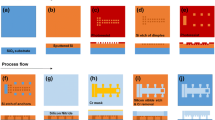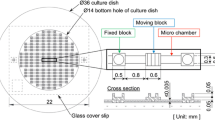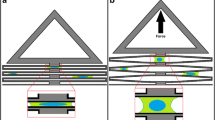Abstract
A novel, completely transparent bio-MEMS (bio-Micro Electro Mechanical System) device has been devised and manufactured using finite element analysis (FEA) and micro-fabrication techniques. The device has been designed to be used for testing the mechanical properties of single living cells, it is versatile and suitable for coupling with other analysis techniques. Furthermore, being completely transparent, it can be used with either transmission or reflection microscopes. The transparent bio-MEMS is based on a silicon dioxide–silicon nitride structure and, since the main goal is to test living cells, it is meant to work in a liquid environment and allow for cell stretching. Sensors for cell deformation and for platform displacement are also present and the required sensitivity for single cell analyses is granted. The device will moreover allow the recording of the stress–strain curve for single living cells.





Similar content being viewed by others
References
Addae-Mensah KA, Wikswo JP (2008) Analysis of application patterns of Z-type MEMS microspring. Exp Biol Med 233:792–809
Ahassan E, Heinz W, Antonik M, D’Costa N, Nageswaran S, Schoenenberger C, Hoh J (1998) Relative microelastic mapping of living cells by atomic force microscopy. Biophys J 74:1564–1578
Bao G, Suresh S (2003) Cell and molecular mechanics of biological materials. Nat Mater 2:715–725
Dai J, Sheetz M (1995) Mechanical properties of neuronal growth cone membranes studied by tether formation with laser optical tweezers. Biophys J 68:988–996
Guck J, Schinkinger S, Lincoln B, Wottawah F, Ebert S, Romeyke M, Lenz D, Erickson HM, Ananthakrishnan R, Mitchell D, Käs J, Ulvick S, Bilby C (2005) Optical deformability as an inherent cell marker for testing malignant transformation and metastatic competence. Biophys J 88:3689–3698
Harris AK, Wild P, Stopak D (1980) Silicone rubber substrata: a new wrinkle in the study of cell locomotion. Science 208:177–179
Jay AWL, Canham PB (1977) Viscoelastic properties of the human red blod cell membrane. II. Area and volume of individual red cells entering a micropipette. Biophys J 17:169–178
Lee BK, Song YH, Yoon JB (2009) Indium Tin Oxide (ITO) transparent MEMS Switches. In: IEEE 22nd international conference on micro electro mechanical systems, pp 148–151
Li H, Gengchen S (2009) Analysis of application patterns of Z-type MEMS microspring. Microsyst Technol 15:527–533
Scuor N, Gallina P, Panchawagh HV, Mahajan RL, Sbaizero O, Sergo V (2006) Design of a novel MEMS platform for the biaxial stimulation of living cells. Biomed Microdevices 8:239–246
Serrell DB, Oreskovic TL, Slifka AJ, Mahajan RL, Finch DS (2007) A uniaxial bioMEMS device for quantitative force-displacement measurements. Biomed Microdevices 9:267–275
Swanepoel R (1983) Determination of the thickness and optical constants of amorphous silicon. J Phys E Sci Instrum 16:1214–1222
Tabataa O, Kawahataa K, Sugiyamaa S, Igarashia I (1989) Mechanical property measurements of thin films using load-deflection of composite rectangular membranes. Sens Actuators 20:135–141
Thoumine O, Ott A (1997) Time scale dependent viscoelastic and contractile regimes in fibroblasts probed by microplate manipulation. J Cell Sci 110:2109–2116
Vriens L, Rippens W (1983) Optical constants of absorbing thin solid films on a substrate. Appl Opt 22:4105–4110
Author information
Authors and Affiliations
Corresponding author
Rights and permissions
About this article
Cite this article
Fior, R., Maggiolino, S., Lazzarino, M. et al. A new transparent Bio-MEMS for uni-axial single cell stretching. Microsyst Technol 17, 1581 (2011). https://doi.org/10.1007/s00542-011-1325-8
Received:
Accepted:
Published:
DOI: https://doi.org/10.1007/s00542-011-1325-8




